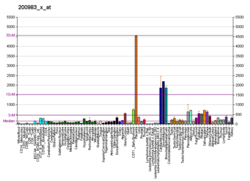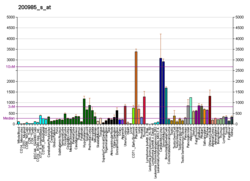CD59
Bu madde, öksüz maddedir; zira herhangi bir maddeden bu maddeye verilmiş bir bağlantı yoktur. (Eylül 2022) |
CD59 glikoproteini, MAC baskılayıcı protein (MAC-IP), membran reaktif liziz inhibitörü veya protektin olarak da bilinen, insanlarda CD59 geni tarafından ile kodlanan bir proteindir.[4] LY6/uPAR/alfa-nörotoksin protein ailesine aittir.[5]
CD59, bir glikofosfatidilinozitol (GPI) tutucusu yoluyla konak hücrelere bağlanır. Kompleman etkinleşmesi, konak hücrelerinde C5b678 çökeltilmesine yol açtığında, CD59, C9'un polimerleşmesini ve membran atak kompleksini oluşturmasını önleyebilir.[6] Ayrıca, CD59-CD9 kompleksinin endositozu gibi etkin önlemler alması için hücreye sinyal verebilir.[5]
Kırmızı kan hücreleri üzerinde CD59 dışa vurumunu ve çürüme hızlandırıcı faktörü azaltan GPI'yi etkileyen mutasyonlar paroksismal noktürnal hemoglobinüri ile sonuçlanır.[7]
HIV, insan sitomegalovirüsü ve vaksinya gibi virüsler, kompleman tarafından lizizlerini önlemek için konak hücre CD59'unu kendi viral zarflarına katar.[8]
Kaynakça[değiştir | kaynağı değiştir]
- ^ a b c GRCh38: Ensembl release 89: ENSG00000085063 - Ensembl, May 2017
- ^ "İnsan PubMed Başvurusu:". National Center for Biotechnology Information, U.S. National Library of Medicine.
- ^ "Fare PubMed Başvurusu:". National Center for Biotechnology Information, U.S. National Library of Medicine.
- ^ "Entrez Gene: CD59 molecule, complement regulatory protein".
- ^ a b "Structure, distribution, and functional role of protectin (CD59) in complement-susceptibility and in immunotherapy of human malignancies (Review)". International Journal of Oncology. 13 (2). Aug 1998. ss. 305-18.
- ^ "Defining the CD59-C9 binding interaction". J. Biol. Chem. 281 (37). Eylül 2006. ss. 27398-27404.
- ^ "Diagnosis and management of paroxysmal nocturnal hemoglobinuria". Blood. 106 (12). 2005. ss. 3699-709.
- ^ "Cell signals transduced by complement". Mol. Immunol. 41 (6-7). Temmuz 2004. ss. 583-597.
Konuyla ilgili yayınlar[değiştir | kaynağı değiştir]
- Tandon N, Morgan BP, Weetman AP (1992). "Expression and function of membrane attack complex inhibitory proteins on thyroid follicular cells". Immunology. 75 (2). ss. 372-7. PMC 1384722 $2. PMID 1372592.
- Holmes CH, Simpson KL, Okada H, Okada N, Wainwright SD, Purcell DF, Houlihan JM (1992). "Complement regulatory proteins at the feto-maternal interface during human placental development: distribution of CD59 by comparison with membrane cofactor protein (CD46) and decay accelerating factor (CD55)". Eur. J. Immunol. 22 (6). ss. 1579-1585. doi:10.1002/eji.1830220635. PMID 1376264.
- Hahn WC, Menu E, Bothwell AL, Sims P, Bierer B (1992). "Overlapping but nonidentical binding sites on CD2 for CD58 and a second ligand CD59". Science. 256 (5065). ss. 1805-1807. doi:10.1126/science.1377404. PMID 1377404.
- Ninomiya H, Sims PJ (1992). "The human complement regulatory protein CD59 binds to the alpha-chain of C8 and to the "b"domain of C9". J. Biol. Chem. 267 (19). ss. 13675-80. PMID 1377690.
- Petranka JG, Fleenor DE, Sykes K, Kaufman RE, Rosse WF (1992). "Structure of the CD59-encoding gene: further evidence of a relationship to murine lymphocyte antigen Ly-6 protein". Proc. Natl. Acad. Sci. U.S.A. 89 (17). ss. 7876-7879. doi:10.1073/pnas.89.17.7876. PMC 49817 $2. PMID 1381503.
- Motoyama N, Okada N, Yamashina M, Okada H (1992). "Paroxysmal nocturnal hemoglobinuria due to hereditary nucleotide deletion in the HRF20 (CD59) gene". Eur. J. Immunol. 22 (10). ss. 2669-2673. doi:10.1002/eji.1830221029. PMID 1382994.
- Rooney IA, Morgan BP (1992). "Characterization of the membrane attack complex inhibitory protein CD59 antigen on human amniotic cells and in amniotic fluid". Immunology. 76 (4). ss. 541-7. PMC 1421564 $2. PMID 1383132.
- Tone M, Walsh LA, Waldmann H (1992). "Gene structure of human CD59 and demonstration that discrete mRNAs are generated by alternative polyadenylation". J. Mol. Biol. 227 (3). ss. 971-976. doi:10.1016/0022-2836(92)90239-G. PMID 1383553.
- Philbrick WM, Palfree RG, Maher SE, Bridgett MM, Sirlin S, Bothwell AL (1990). "The CD59 antigen is a structural homologue of murine Ly-6 antigens but lacks interferon inducibility". Eur. J. Immunol. 20 (1). ss. 87-92. doi:10.1002/eji.1830200113. PMID 1689664.
- Sawada R, Ohashi K, Anaguchi H, Okazaki H, Hattori M, Minato N, Naruto M (1990). "Isolation and expression of the full-length cDNA encoding CD59 antigen of human lymphocytes". DNA Cell Biol. 9 (3). ss. 213-220. doi:10.1089/dna.1990.9.213. PMID 1692709.
- Yamashina M, Ueda E, Kinoshita T, Takami T, Ojima A, Ono H, Tanaka H, Kondo N, Orii T (1990). "Inherited complete deficiency of 20-kilodalton homologous restriction factor (CD59) as a cause of paroxysmal nocturnal hemoglobinuria". N. Engl. J. Med. 323 (17). ss. 1184-1189. doi:10.1056/NEJM199010253231707. PMID 1699124.
- Rooney IA, Morgan BP (1991). "Protection of human amniotic epithelial cells (HAEC) from complement-mediated lysis: expression on the cells of three complement inhibitory membrane proteins". Immunology. 71 (3). ss. 308-11. PMC 1384423 $2. PMID 1702747.
- Watts MJ, Dankert JR, Morgan EP (1990). "Isolation and characterization of a membrane-attack-complex-inhibiting protein present in human serum and other biological fluids". Biochem. J. 265 (2). ss. 471-7. doi:10.1042/bj2650471. PMC 1136908 $2. PMID 2302178.
- Okada H, Nagami Y, Takahashi K, Okada N, Hideshima T, Takizawa H, Kondo J (1989). "20 KDa homologous restriction factor of complement resembles T cell activating protein". Biochem. Biophys. Res. Commun. 162 (3). ss. 1553-1559. doi:10.1016/0006-291X(89)90852-8. PMID 2475111.
- Davies A, Simmons DL, Hale G, Harrison RA, Tighe H, Lachmann PJ, Waldmann H (1989). "CD59, an LY-6-like protein expressed in human lymphoid cells, regulates the action of the complement membrane attack complex on homologous cells". J. Exp. Med. 170 (3). ss. 637-654. doi:10.1084/jem.170.3.637. PMC 2189447 $2. PMID 2475570.
- Sawada R, Ohashi K, Okano K, Hattori M, Minato N, Naruto M (1989). "Complementary DNA sequence and deduced peptide sequence for CD59/MEM-43 antigen, the human homologue of murine lymphocyte antigen Ly-6C". Nucleic Acids Res. 17 (16). s. 6728. doi:10.1093/nar/17.16.6728. PMC 318369 $2. PMID 2476718.
- Sugita Y, Tobe T, Oda E, Tomita M, Yasukawa K, Yamaji N, Takemoto T, Furuichi K, Takayama M (1990). "Molecular cloning and characterization of MACIF, an inhibitor of membrane channel formation of complement". J. Biochem. 106 (4). ss. 555-7. doi:10.1093/oxfordjournals.jbchem.a122893. PMID 2606909.
- Bora NS, Gobleman CL, Atkinson JP, Pepose JS, Kaplan HJ (1994). "Differential expression of the complement regulatory proteins in the human eye". Invest. Ophthalmol. Vis. Sci. 34 (13). ss. 3579-84. PMID 7505007.
- Kieffer B, Driscoll PC, Campbell ID, Willis AC, Van Der Merwe PA, Davis SJ (1994). "Three-dimensional solution structure of the extracellular region of the complement regulatory protein CD59, a new cell-surface protein domain related to snake venom neurotoxins". Biochemistry. 33 (15). ss. 4471-4482. doi:10.1021/bi00181a006. PMID 7512825.
- Kennedy SP, Rollins SA, Burton WV, Sims PJ, Bothwell AL, Squinto SP, Zavoico GB (1994). "Protection of porcine aortic endothelial cells from complement-mediated cell lysis and activation by recombinant human CD59". Transplantation. 57 (10). ss. 1494-501. doi:10.1097/00007890-199405000-00017. PMID 7515200.
Dış bağlantılar[değiştir | kaynağı değiştir]
- Medical Subject Headings CD59+Antigen
- Human CD59 24 Haziran 2018 tarihinde Wayback Machine sitesinde arşivlendi. genome location and CD59 28 Nisan 2018 tarihinde Wayback Machine sitesinde arşivlendi. gene details page in the UCSC Genome Browser.






